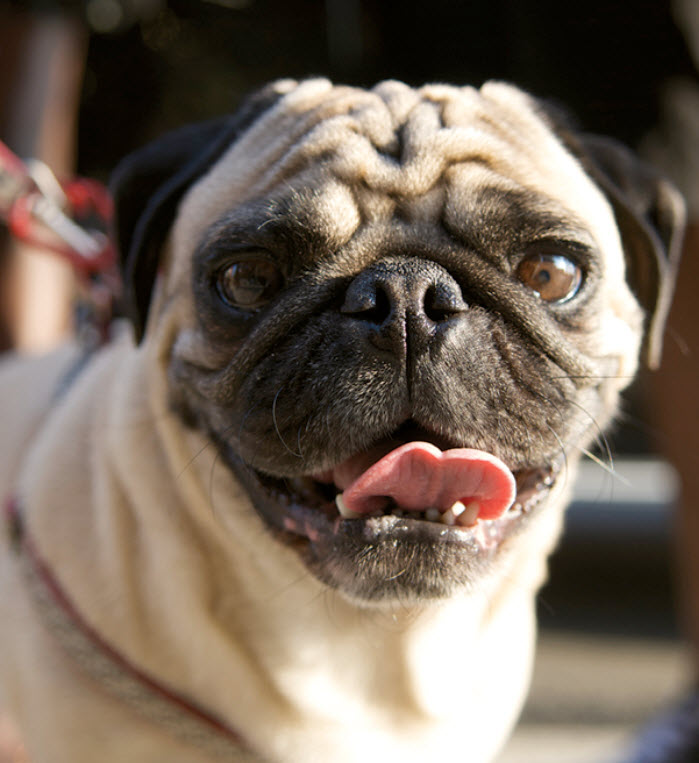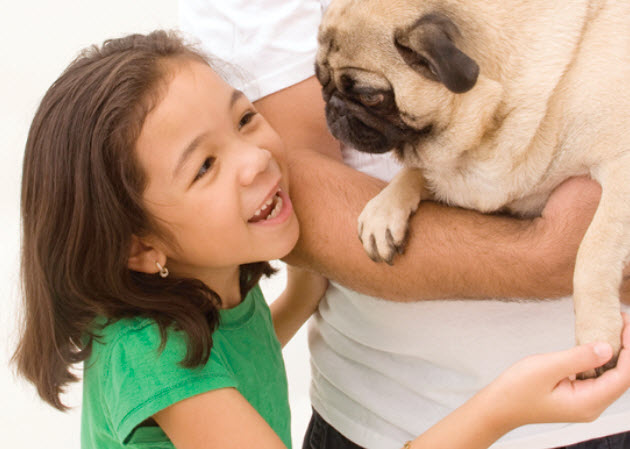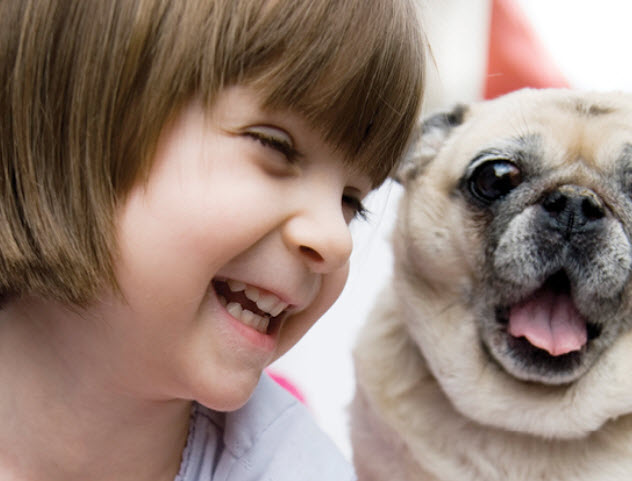
The Pug - What a Pup!
If you're looking for a great mixture of spunky, cute, and silly, a Pug might be just the right addition to your family. Pugs are well-loved because of certain characteristics:
- Outgoing, playful personality
- Needs minimal exercise
- Vigilant watchdog with a ready bark
- Even-tempered, affectionate, and happy-go-lucky
- Good with children and other pets
- Small, but sturdy
Avoid Pug problems by understanding that they can:
- Be independent and strong-willed
- Prone to quite a few health problems
- Noisy, with a lot of snorting, snuffling, and wheezing; may snore
- Be difficult to housetrain
- An indoor dog that doesn’t do well in the heat
- Prone to boredom and separation anxiety when left alone and will find trouble
 Pugs are joyful pals and make great travel companions—who could leave those big brown eyes at home?
Pugs are joyful pals and make great travel companions—who could leave those big brown eyes at home?
Pugs were first bred in China centuries ago. They were treasured pets kept by royalty; it was common for a Pug to have her own guard, palace, and even a personal chef! Many Pug owners agree that their ancestry is strong in that they still behave like royalty! Pugs were first acknowledged by the AKC in 1885 and were quickly welcomed into American homes. The Pug’s moderate exercise requirements make her a great apartment pet. Pugs are a generally healthy breed with an average lifespan of 13-15 years.
Your Pug's Health
We know that because you care so much about your dog, you want to take good care of her. That is why we have summarized the health concerns we will be discussing with you over the life of your Pug. By knowing about health concerns specific to Pugs, the doctors and staff of East Dallas Veterinary Clinic can tailor a preventive health plan to watch for and hopefully prevent some predictable risks.
Many diseases and health conditions are genetic, meaning they are related to your pet’s breed. There is a general consensus among canine genetic researchers and veterinary practitioners that the conditions we’ve described herein have a significant rate of incidence and/or impact in this breed. That does not mean your dog will have these problems; it just means that she is more at risk than other dogs. We will describe the most common issues seen in Pugs to give you an idea of what may come up in her future. Of course, we can’t cover every possibility here, so always check with us if you notice any unusual signs or symptoms.
This guide contains general health information important to all canines as well as the most important genetic predispositions for Pugs. This information helps you and us together plan for your pet’s unique medical needs. At the end of the article, we have also included a description of what you can do at home to keep your Pug looking and feeling her best. You will know what to watch for, and we will all feel better knowing that we’re taking the best possible care of your pal.
General Health Information for your Pug
Dental Disease
Dental disease is the most common chronic problem in pets, affecting 80% of all dogs by age two. Unfortunately, your Pug is more likely than other dogs to have problems with her teeth. Dental disease starts with tartar build-up on the teeth and progresses to infection of the gums and roots of the teeth. If we don’t prevent or treat dental disease, your buddy may lose her teeth and be in danger of damage to her kidneys, liver, heart, and joints. In fact, your Pug's life span may even be cut short by one to three years! We’ll clean your dog’s teeth regularly and let you know what you can do at home to keep those pearly whites clean.
 Infections
Infections
Pugs are susceptible to bacterial and viral infections — the same ones that all dogs can get — such as parvo, rabies, and distemper. Many of these infections are preventable through vaccination, which we will recommend based on her age, the diseases we see in our area, and other factors.
Obesity
Obesity can be a significant health problem in Pugs. It is a serious disease that may cause or worsen joint problems, metabolic and digestive disorders, back pain, and heart disease. Though it’s tempting to give your pal food when she looks at you with those soulful eyes, you can “love her to death” with leftover people food and doggie treats. Instead, give her a hug, brush her fur or teeth, play a game with her, or perhaps take her for a walk. She’ll feel better, and so will you!
Parasites
All kinds of worms and bugs can invade your Pug's body, inside and out. Everything from fleas and ticks to ear mites can infest her skin and ears. Hookworms, roundworms, heartworms, and whipworms can get into her system in a number of ways: drinking unclean water, walking on contaminated soil, or being bitten by an infected mosquito. Some of these parasites can be transmitted to you or a family member and are a serious concern for everyone. For your canine friend, these parasites can cause pain, discomfort, and even death, so it’s important that we test for them on a regular basis. We’ll also recommend preventive medication as necessary to keep her healthy.
Spay or Neuter
One of the best things you can do for your Pug is to have her spayed (neutered for males). In females, this means we surgically remove the ovaries and usually the uterus, and in males, it means we surgically remove the testicles. Spaying or neutering decreases the likelihood of certain types of cancers and eliminates the possibility of your pet becoming pregnant or fathering unwanted puppies. Performing this surgery also gives us a chance, while your pet is under anesthesia, to identify and address some of the diseases your dog is likely to develop. For example, if your pet needs hip X-rays or a puppy tooth extracted, this would be a good time—it’s more convenient for you and easier on your friend too. Routine blood testing prior to surgery also helps us to identify and take precautions against common problems that increase anesthetic or surgical risk. Don’t worry; we’ll discuss the specific problems we will be looking for when the time arrives.
Genetic Predispositions for Pugs
Liver Problems
Your Pug is more likely than other dogs to have a liver disorder called portosystemic shunt (PSS). Some of the blood supply that should go to the liver goes around it instead, depriving the liver of the blood flow it needs to grow and function properly. If your friend has PSS, his liver cannot remove toxins from his bloodstream effectively. To check for this problem, we’ll conduct a liver function test in addition to a standard pre-anesthetic panel every time he undergoes anesthesia. If he develops symptoms such as stunted growth or seizures, we’ll test his blood and possibly conduct an ultrasound scan of his liver. Surgery may be needed, but in some cases, we can treat with a special diet and medication.
Eye Problems
Not many things have as dramatic an impact on your dog's quality of life as the proper functioning of his eyes. Unfortunately, Pugs can inherit or develop a number of different eye conditions, some of which may cause blindness if not treated right away, and most of which can be extremely painful! We will evaluate his eyes at every examination to look for any signs for concern.
- Because your Pug has eyeballs that naturally protrude, he is more vulnerable to eye injuries. Scrapes or punctures to the cornea (the protective covering on the eyeball) are the most common injuries. Don’t let your pet ride in the car with his head out the window as this is a frequent cause of eye injuries. Not only do eye injuries hurt, they can become infected and affect his vision. Call us at (214) 328-9935 right away if your pet has any problems with his eyes. A damaged cornea is painful and should be treated immediately. Medication and sometimes surgery may be required.
- Entropion is a condition in which the eyelid rolls inward, causing the eyelashes to rub against the cornea (the surface of the eyeball). This is an extremely irritating and painful condition that can ultimately lead to blindness. Entropion can occur in any dog breed, however, your Pug is especially at risk for this heritable disorder. Surgical correction is usually successful if performed early.
- Dry eye, also known as keratoconjunctivitis sicca or KCS, is common in Pugs. KCS reduces the amount of fluid produced by the tear glands such that they are no longer able to keep the eyes moist. This results in sore, itchy eyes and infections. Symptoms of KCS include a dull, dry appearance or thick discharge from the eyes, squinting, and pawing at the eyes. KCS is a painful condition; please call us immediately if you notice any of these signs, and we’ll conduct a tear test on your pet. If he has this disease, we’ll prescribe ointment that you’ll need to apply for the rest of your dog’s life.
 Diabetes
Diabetes
Diabetes mellitus is a fairly common disease in dogs. Any breed can be affected, but Pugs have an above average incidence. Dogs with diabetes are unable to regulate the metabolism of sugars in their bodies and require daily insulin injections. Diabetes is a serious condition and one that is important to diagnose and treat as early as possible. Symptoms include increased eating, drinking, and urination, along with weight loss. If he shows signs, we will conduct lab tests to determine if he has this condition and discuss treatment options with you. Treatment requires a serious commitment of time and resources. Well-regulated diabetic dogs today have the same life expectancy as other canines.
Allergies
In humans, allergies to pollen, mold, or dust make people sneeze. In dogs, rather than sneezing, allergies make their skin itchy. We call this skin allergy “atopy”, and Pugs often have it. The feet, belly, folds of the skin, and ears are most commonly affected. Symptoms typically start between the ages of one and three and can get worse every year. Licking the paws, rubbing the face, and frequent ear infections are the most common signs of allergies. The good news is that there are many treatment options available for these conditions.
Mange
Demodex is a microscopic mite that lives in the hair follicles of all dogs. Normally a dog’s immune system keeps the mites in check, but some breeds, like your Pug, may develop an overabundance of these mites. In mild cases, pet owners may notice a few dry, irritated, hairless lesions. These often occur on the face or feet and may or may not be itchy. Secondary skin infections may also occur. Prompt veterinary care is important to keep the disease from getting out of hand. Many pets seem to outgrow the problem, while others require lifelong management.
Skin Infections
Your Pug is prone to a form of skin infection called lip-fold pyoderma, which occurs because the folds of skin along the lower jaw are usually moist. Bacteria and yeast can readily thrive here and cause a reddened, smelly area that is uncomfortable for your dog. We will examine him for this problem often (let us know if you see signs as well), and we’ll recommend treatment with antibiotics as necessary. When symptoms are severe, the excess skin folds can also be surgically removed.
 Granulomatous Meningoencephalitis (GME)
Granulomatous Meningoencephalitis (GME)
GME is an acute, progressive inflammatory disease that affects the central nervous system. It can cause severe and often irreversible damage to the brain. Middle-aged, small breed dogs such as Pugs are more susceptible than other breeds. The cause of GME is unknown, but three distinct syndromes of GME have been recognized. Symptoms may be acute, leading rapidly to death; they may progress chronically over several months; or occasionally, only the eyes are affected. Treatment includes corticosteroids, but the response to therapy is variable and the prognosis is generally poor.
Bone and Joint Problems
A number of different musculoskeletal problems have been reported in Pugs. While it may seem overwhelming, each condition can be diagnosed and treated to prevent undue pain and suffering. With diligent observation at home and knowledge about the diseases that may affect your friend's bones, joints, or muscles, you will be able to take great care of him throughout his life.
- Both hips and elbows are at risk for dysplasia, an inherited disease that causes the joints to develop improperly and results in arthritis. Stiffness in your Pug's elbows or hips may become a problem for him, especially as he matures. You may notice that he begins to show lameness in his legs or has difficulty getting up from lying down. We can treat the arthritis—the sooner the better—to minimize discomfort and pain. We’ll take X-rays of your dog’s bones to identify issues as early as possible. Surgery is also sometimes a good option in severe and life-limiting cases. And keep in mind that overweight dogs may develop arthritis years earlier than those of normal weight, causing undue pain and suffering!
- Young Pugs may be prone to a painful degenerative hip condition called Legg-Calve-Perthes disease. The exact cause of this condition is still not completely understood, but it is thought to be caused by a reduced blood supply to the hip, which causes the femoral head (the top of the thigh bone) to become brittle and fracture easily. Usually occurring between six and nine months of age, LCP causes pain and lameness in one or both rear legs, and often requires surgery.
- Sometimes your Pug's kneecap (patella) may slip out of place. This is called patellar luxation. You might notice that your pet, while running, suddenly picks up a back leg or skips and hops for a few strides. He might then kick his leg out sideways to pop the kneecap back in place. These are common signs of patellar luxation. If the problem is mild and involves only one leg, your friend may not require much treatment beyond arthritis medication. When symptoms are severe, surgery may be needed to realign the kneecap to keep it from luxating further.
Spinal Deformities
Pugs are more likely than other canines to be born with spinal deformities, a condition called hemivertebrae, which may lead to spinal cord damage, instability, or disability. We’ll take X-rays when your pet is young to ensure that we identify problems early as symptoms can worsen with age, weight, and sometimes activity. During his life, if he develops back problems, we’ll rule out any other causes, such as a slipped spinal disc or arthritis. If a deformity is diagnosed, we’ll prescribe medication, acupuncture, or rehabilitation as needed.
Mast Cell Tumor
Mast cell tumors are a particularly nasty type of skin cancer found more often in Pugs than other breeds. The sooner these tumors are surgically removed, the better. Unfortunately, mast cell tumors often look very similar to other kinds of skin lumps and lesions, many of which are not harmful. Therefore, all suspicious lumps should be tested and surgically removed as soon as possible. Many cancers are cured by surgical removal, so early detection is critical.
Degenerative Myelopathy
Degenerative myelopathy is a neurologic condition, similar to ALS or Lou Gehrig's disease in people, that causes weakness and poor nerve function in the hind legs. It affects Pugs more frequently than other breeds. If your dog has this disease, he will become increasingly weak and disabled in the hind legs, eventually suffering from paralysis in his hindquarters, which also leads to incontinence. Rehabilitation, exercise, acupuncture, and dietary supplements can be helpful, but there is no cure for degenerative myelopathy. A genetic test is available to determine whether your dog is at risk for this heritable disease.
Bladder or Kidney Stones
There are a few different types of stones that can form in the kidney or in the bladder, and Pugs are more likely to develop them than other breeds. We’ll periodically test his urine for telltale signs indicating the presence of kidney and bladder stones, which in addition are very painful! If your buddy has blood in his urine, can’t urinate, or is straining to urinate, it is a medical emergency. Call us immediately!
Respiratory Distress Syndrome
Respiratory distress syndrome, also known as brachycephalic syndrome, affects dogs with a short nose, like your Pug. Short-nosed dogs have the same amount of tissue in their noses and throats as longer-nosed dogs, but with less area to contain it. As a consequence, the soft palate at the back of the roof of the mouth is too long and may hang down into the airway. These dogs’ nostrils are often too small, and sometimes the trachea, or windpipe, is narrow and undersized as well. All of these differences can lead to a narrow and obstructed airway such that many of these dogs can barely breathe! Watch for exercise intolerance, loud breathing, coughing, bluish gums, or fainting. With his short nose, your pet is also more likely to develop other problems, such as flatulence from excessive air intake, pneumonia from aspirating food, and heat stroke. In severe cases, surgical correction may be recommended to alleviate airway obstruction.
Taking Care of Your Pug at Home
 Much of what you can do to keep your dog happy and healthy is common sense, just like it is for people. Watch her diet, make sure she gets plenty of exercise, regularly brush her teeth and coat, and call us or a pet emergency hospital when something seems unusual (see “What to Watch For” below). Be sure to adhere to the schedule of examinations and vaccinations that we recommend for her. This is when we’ll give her the necessary “check-ups” and test for diseases and conditions that are common in Pugs. Another very important step in caring for your pet is signing up for pet health insurance. There will certainly be medical tests and procedures she will need throughout her life and pet health insurance will help you cover those costs.
Much of what you can do to keep your dog happy and healthy is common sense, just like it is for people. Watch her diet, make sure she gets plenty of exercise, regularly brush her teeth and coat, and call us or a pet emergency hospital when something seems unusual (see “What to Watch For” below). Be sure to adhere to the schedule of examinations and vaccinations that we recommend for her. This is when we’ll give her the necessary “check-ups” and test for diseases and conditions that are common in Pugs. Another very important step in caring for your pet is signing up for pet health insurance. There will certainly be medical tests and procedures she will need throughout her life and pet health insurance will help you cover those costs.
Routine Care, Diet, and Exercise
Build her routine care into your schedule to help your Pug live longer, stay healthier, and be happier during her lifetime. We cannot overemphasize the importance of a proper diet and exercise routine.
- Supervise your pet as you would a toddler. Keep doors closed, pick up after yourself, and block off rooms as necessary. This will keep her out of trouble and away from objects she shouldn’t put in her mouth.
- She has low grooming needs. Brush her coat as needed, at least weekly.
- Pugs often have serious problems with their teeth, so you’ll need to brush them at least three times a week!
- Clean her ears weekly, even as a puppy. Don’t worry—we’ll show you how!
- Her deep wrinkles need to be cleaned and dried often to prevent infections.
- She is well suited for apartment living; she will need a daily walk and regular inside play.
- She is sensitive to temperature extremes; avoid any prolonged exposure and be very alert to the signs of heat stress.
- Keep your dog’s diet consistent and don’t give her people food.
- Feed a high-quality diet appropriate for her age.
- Exercise your dog regularly, but don’t overdo it at first.
What to Watch For
Any abnormal symptom could be a sign of serious disease or it could just be a minor or temporary problem. The important thing is to be able to tell when to seek veterinary help and how urgently. Many diseases cause dogs to have a characteristic combination of symptoms, which together can be a clear signal that your Pug needs help.
Office Calls
Give us a call for an appointment if you notice any of these types of signs:
- Change in appetite or water consumption
- Tartar build-up, bad breath, red gums, or broken teeth
- Itchy skin (scratching, chewing, or licking); hair loss
- Lethargy, mental dullness, or excessive sleeping
- Fearfulness, aggression, or other behavioral changes
- Dry, scaly, sometimes itchy hairless patches on face or paws
- Lumps or bumps – regardless of size
- Increased hunger and thirst, weight loss
- Slow or stunted growth; sometimes seizes after eating
Emergencies
Seek medical care immediately if you notice any of these types of signs:
- Scratching or shaking the head, tender ears, or ear discharge
- Inability or straining to urinate; discolored urine
- Cloudiness, redness, itching, or any other abnormality involving the eyes
- Dragging the hind toes and hind limb weakness
- Loud breathing, tires easily at exercise
- Leg stiffness; reluctance to rise, sit, use stairs, run, or jump; “bunny hopping”
